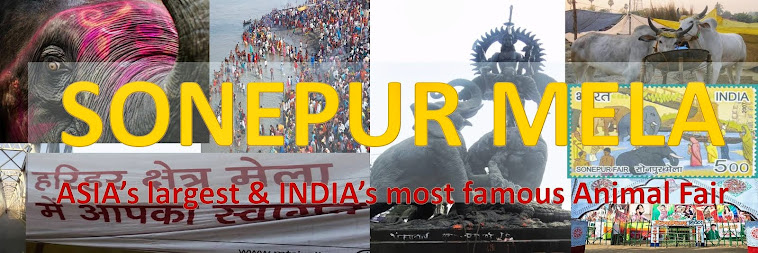For centuries, the Sonepur cattle fair in the Saran district of Bihar was one of the largest of its kind on the continent, with traders coming from as far as central Asia each year to buy and sell all kinds of animals, including elephants and horses.
Over the years, however, the fair
has seen a noticeable decline in visitors, which attendees blame on the state’s
lack of interest in the event. This year, the Bihar tourism department took
over management of the event from the district fair committee in hopes of
attracting foreign tourists, but the number of traders and visitors has dropped
off only a week after the fair began Nov. 27, with no foreign tourists in
sight.
One district administrative
official, who asked to remain anonymous because he was not authorized to speak
to the media, estimated that the fair was drawing not even 25,000 people a day,
from about 100,000 a day in past years.
Traders say that the cattle fair
has lost its rustic charm and that animal trading has been pushed to the
background. Just a week into the fair, which ends Dec. 26, all that was left
were a few stalls selling cheap electronic gadgets, handicrafts, costume
jewelry, utensils and unhygienic food items.
One elephant trader, Mohammed
Issad, said his fellow traders have lost interest in the lackluster Sonepur
fair, and he recalled wistfully of the days when elephants were the biggest stars. “I’ve been coming to the
Sonepur fair for the last 25 years, when about 500 elephants used to come,” he
said. “There was not even an inch of space vacant here in this mango orchard
elephant ground in those days.”
Bihar’s ban on elephant trade has
reduced the number of elephants at the fair over the years, but traders have
found ways around the rules by labeling elephant sales as gifts. Last year, 35
elephants were for sale, but this year, only two elephants were left a week
after the fair began, both of them Mr. Issad’s, and he was getting ready to
leave with them.
Lagandeo Chaudhury, a
septuagenarian horse trader from Uttar Pradesh who has been coming to Sonepur
fair since 1960, said he has never seen such a slump in the animal trade. “There
are no buyers today, and even the traders from other states have stopped coming
in,” he said a week after the fair started. “I’m also leaving with my horses as
staying here would serve no purpose.”
The state tourism department had
solicited bids from private companies to revamp the fair, giving the project to
the highest bidder, Impact Communications of Delhi, which offered 12 million
rupees ($220,000). The government asked the company to build Swiss cottages for
foreign tourists and to put up large tents that would hold daily cultural
events.
 A total of 23 tourists, from
Australia, the United States, Japan and Belgium, stayed in the 20 cottages in
the first week of the fair, but since then no one has used the houses, which
cost 4,110 rupees a night, an exorbitant amount for this part of India. The
cultural exhibitions, like the one featuring an artist from Orissa state who
made sand replicas of Bihar’s historical structures, were likewise devoid of
visitors.
A total of 23 tourists, from
Australia, the United States, Japan and Belgium, stayed in the 20 cottages in
the first week of the fair, but since then no one has used the houses, which
cost 4,110 rupees a night, an exorbitant amount for this part of India. The
cultural exhibitions, like the one featuring an artist from Orissa state who
made sand replicas of Bihar’s historical structures, were likewise devoid of
visitors.
“It’s all loss, a huge loss,”
said Nagendra Kumar, an employee of the state tourist department.
Ravi Nair, manager of Impact
Communications, blamed the dismal turnout on the lack of coordination between state
government departments to promote and organize the event. “At the Pushkar
cattle fair in Rajasthan, the state animal husbandry department puts in lot of
resources and energy to make it successful every year,” he said in a telephone
interview.
“Our total investment is two
crore [20 million] rupees,” he said. “And forget about profit — I’m not sure
we’ll be able to recover our money,” he said. Mohammed Babbar, a dog trader
from the Patna district, has been a regular attendee of the Sonepur fair, bringing
hundreds of canines, but he said he would think twice about coming next year.
“What to do? I can’t even recover
my transportation costs,” he said. “There is no encouragement from the state
government at all to keep the Sonepur fair alive.”
Devendra Rajak, joint director of
the state tourism department, acknowledged that the number of attendees has
fallen this year but declined to identify any specific cause. He said that “a
lot of improvements have been made in the fair from this year ” and that the
department would do its best to attract visitors next year.
Meanwhile, what life is left in
this year’s fair can be found in several sleazy theaters, plastered with
revealing posters of Bollywood beauties, and country liquor shops and bars,
which are enjoying a booming business, thanks to visitors from the villages.
(Courtesy:- AMARNATH TEWARY & NYT)



No comments:
Post a Comment